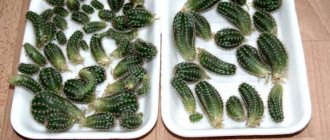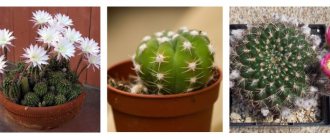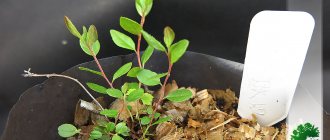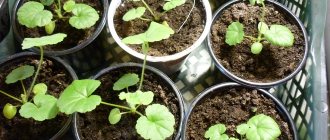Growing cacti from seeds is a complex but very exciting process. Growing cacti from seeds, we observe the entire development process from seed to adult state of these absolutely amazing plants. In this way, you can grow rare species of cacti and succulents that are rarely on sale. And most importantly, cacti grown from seeds will not need acclimatization. But this requires time and patience.
Selection of seed
Choosing seed material is a responsible task, and it is better for novice gardeners to purchase it in a specialized store. To get a plant of pure lines, you should buy seed only from trusted manufacturers or their official suppliers. Leading breeders value their reputation, so they sell seeds with excellent genetic potential and high germination.
Another important point that you should pay attention to when purchasing seed is its freshness, since the shelf life of seeds is only 6 months.
Selecting seeds
Before sowing cacti with seeds, you need to decide on the method of obtaining them. Planting material can be purchased at a flower shop or extracted yourself. The first option is much simpler - you immediately begin planting the selected variety.
To get cactus seeds at home, you need to wait until the end of the flowering period. A box with seeds will remain in place of the inflorescence. The downside of this method is the long waiting time. In addition, it will be possible to grow only those plants from which the planting material was collected.
The appearance of the seeds depends on the variety. They may vary in color, shape and size. Cacti from seeds bloom much later than those grown vegetatively.
The right time to sow cacti
If you have your own greenhouse equipped with fluorescent lamps, you can sow cacti at any time of the year. Please note that the installation of incandescent lamps is not allowed, because overheating of sprouts can lead to their death.
If there are no sources of daylight in the house, experts recommend postponing sowing until spring. Early spring is the most favorable time for sowing cacti. It is at this time that there is a gradual increase in daylight hours and the intensity of sunlight increases.
Autumn plantings are generally excluded. During this period, nature falls asleep, the rhythm of plant development slows down and seed germination will not give the desired result.
How to germinate cactus seeds
Conditions for germination of cactus seeds
For successful germination of seeds of many types of cacti, a daytime temperature of about +26°-30°C is required, and at night it is 7-10°C lower. Moderate soil moisture (not damp, not dry, but slightly damp) and high air humidity.
But as soon as the seeds germinate, there is an urgent need for the third and main growth factor - lighting. And the lighting must be very good!
Growth stimulants, which have proven themselves very well in rooting cuttings and germinating seeds of other indoor plants, are rarely used for cacti, since their effect on these particular plants has not been fully studied. If you want to try such a remedy, it is better to apply it to one cactus, and not to the entire collection.
What and where to sow seeds
To germinate and grow seeds, it is better to use a special greenhouse, which you can purchase in a store or make yourself. But if there is no opportunity to make or buy a greenhouse, then the seeds are simply sown in a bowl.
Drainage, approximately 7-10 mm high, is poured onto the bottom of a bowl (wide tray, low box). Then a layer of loose leaf soil about 2 cm high and a layer of well-washed river sand, about 1.5-2 cm high. The drainage is pre-drained with boiling water, and the soil and sand are fried in the oven or heated in the microwave for disinfection. Sand for sowing is suitable only from river sand, not from a sandbox and must be sifted to remove dust. It is desirable that the particle sizes be 1-3 mm. Unwashed and/or very fine sand, after getting wet, cakes, sticks together and forms a dense crust. This does not allow the nuts of the seedlings to breathe; they quickly die.
Before sowing, cactus seeds must be disinfected. The easiest way to do this is to use 3% hydrogen peroxide; just soak the seeds for 5-10 minutes.
Seeds are sown at a depth recommended for a particular species. Seeds up to 3 mm in size, especially small, dusty ones, are not sprinkled with sand; they are sown directly on the surface. Larger seeds can be sown in furrows no more than 3 mm deep. You have to sow cacti either by hand, selecting each seed individually, or sprinkle very small seeds on the surface of the sand with a pinch. It is advisable to sow seeds with a pinch, of which there are a lot and during germination it is not a pity to thin out the seedlings. If the seeds are rare or have a limited number, plant each one separately.
A word of warning here: the seeds of most cacti are small, and if they fall, they are lost forever. Therefore, open the seeds that arrived in the package carefully, over a table covered with white paper, trying not to spill them.
By the way, the most experienced cacti growers on our forum have already shared their secrets of growing cacti from seeds.
Preparing containers and soil
It is better to plant seeds in a shallow plastic container, the height of which does not exceed 8 cm. The bottom of the cup must have perforation to ensure the free flow of excess liquid. As for the color of the pots, the best option would be white matte containers that are not prone to absorbing sunlight and protect young shoots from overheating. In addition, the cups should have transparent lids that will cover the planted seeds. It is recommended to sow each species separately and mark it with a number or name.
Immediately before sowing, the sowing dishes must be thoroughly washed and disinfected using a strong solution of potassium permanganate or formaldehyde. Ceramic containers can be boiled - this helps get rid of pathogenic microflora and prevent infection of plants.
Cacti grow well in poor soils. Therefore, for sowing, we recommend choosing a special substrate that will have a slightly acidic pH-6 reaction and good water and air permeability. Experts advise making a mixture of coarse sand and leaf soil in equal parts and adding a small amount of charcoal and peat to it. Before adding seeds to the soil, it must be thoroughly disinfected.
What cactus seeds look like (with photo)
Specialty stores offer a wide variety of cactus seeds. Usually, for their first attempt, beginners choose either a mixture of seeds of different varieties, or seeds of fast-growing columnar cacti, or seeds of species that bloom a few years after planting, such as rebutia. You need to know what the seeds of the type and variety of cacti you are interested in look like, otherwise you will be disappointed in the future.
Of course, you can also sow seeds received from another cactus lover. For sowing, you should use seeds that have been stored for no more than one or two years. To prevent possible damage to seedlings by fungal infections, seeds must be cleaned of possible residues of fruit pulp before sowing.
To do this, pour larger seeds into a tea strainer, and smaller ones into a linen bag and wash them thoroughly in warm water, then scatter them on paper and dry.
Look what cactus seeds look like - the photo shows planting material from different groups of these plants:
Sowing cactus seeds
While the seeds are soaking, a drainage layer 1-2 cm thick is placed in the prepared container and 3-4 cm of the prepared substrate is poured on top. In this case, 1/3 of the pot should remain unfilled. Then the soil is spilled with warm boiled water, and shallow holes are made in it with a toothpick at a distance of 2 cm from each other.
Cactus seeds are laid out using tweezers or a sharp pencil, slightly deepening the large ones and leaving the small ones on the surface. All seeds, except astrophytums, should be placed with the ridge down (astrophytums are sown with the ridge up).
After all the seeds have been distributed among the holes, the soil on top is carefully sprayed with water, the container is closed with a transparent lid and placed in a warm, well-lit place. The optimal temperature inside the greenhouse will be +25 degrees. If the room is too cold, then it will be much more difficult to germinate the seeds, and already at +15 degrees the process may stop altogether. In the future, you can use a spray bottle or watering tube to moisturize. In any case, overdrying the substrate is unacceptable, because can lead to the death of crops.
Cacti - botanical features
Cacti are unusual plants native to the New World. It grows in arid areas, desert areas and poorly adapted plateaus of southern countries. The Cactus family is very numerous. It includes about 2500 species. They can be very tiny - no more than 1-3 cm. There are also huge giants, up to 20 m high, which can live up to 150 years. Their stems accumulate up to 2 tons of fresh water. Moreover, it is suitable for drinking. Cacti do not have leaves as such. Or rather, they have changed into spines, bristles of different lengths and shapes.
Emergence of seedlings
The duration of illumination of crops should be at least 12 hours a day, which is provided by natural sunlight (spring) or fluorescent lamps (up to 5000 lux in autumn and winter).
A couple of weeks after sowing the cacti, seed germination will become clearly visible, and with the appearance of the first spines, the plants will need to be ventilated daily. Every day, open the container 1-2 times for ventilation and wipe the lid from the inside to prevent moisture from flowing back.
To avoid the appearance of fungus, many breeders recommend using a 0.5% Quinozol solution at this stage, diluting one tablet of the drug in 2 liters of water.
Where to buy cactus seeds
If you are a beginner and you are interested in trying your hand, we go to the nearest flower shop, where we will find everything you need.
Seeds (as a rule, the package contains seeds of one simple type, even if it is written - a mixture of cactus seeds. We close our eyes to all the variety that was indicated), soil, sand, a container - a greenhouse (you can find a suitable container at home).
If you want to grow more interesting specimens that are hard to find on store shelves, consider the options below.
- You can order seeds through online stores, where there will be a much larger selection of varieties. Don’t be too lazy to find the rating of this store or reviews in advance. In this case, you are also not immune from the “birth” of plants of the same variety.
- There are many sites from collectors and breeders who have received seeds from their mother plants and offer you a choice of 1 piece of any variety with delivery throughout the country.
- You can also search the Internet for sites that offer seeds from foreign nurseries with new products that you will not find in Russia.
- There are many forums for “thorn” lovers, where you can find all the information you are interested in on care and cultivation, pleasant communication, tips and tricks, as well as exchange surplus seeds or plants.
- And finally, if you want to order seeds from well-known Chinese sites, get ready for the fact that everything except cacti will sprout.
Picking cactus shoots
If mold or algae appear on the surface of the substrate, seedlings can be picked at an early age. However, experienced cactus growers advise postponing this procedure, because it can provoke a temporary stop in plant development.
To dive, remove the seedling together from the substrate using a wooden spatula. Then remove the upper part of the root ball, wash the root collars with a solution of potassium permanganate and replant into a new substrate of the same composition. It is recommended to water cacti after the procedure no earlier than 2 days later.
Before planting cactus seeds, prepare the soil and dishes
First we prepare the soil and dishes. Cactus seeds can be sown in low, wide pots or bowls, for example, made of styrofoam. Before planting cactus seeds, wash the dishes with hot water. A convex clay shard is placed on the drainage hole, which, if necessary, can be made in the bottom of the bowl with a pencil. Then the container is filled 2/3 with a soil mixture for cacti, which should be especially loose and, if possible, contain more coarse sand or perlite.
Steamed, and therefore well disinfected, soil mixture provides the best protection against fungal diseases, but this is not necessary. A 0.5 cm layer of broken brick, crushed basalt (lava) or coarse sand is poured on top of the soil. This material is first sifted to a grain size of 1-2 mm, then washed to remove all small dust particles, dried and then scattered over the soil surface in a bowl. As a result, this layer will not provide a breeding ground for randomly germinating pathogens.
Further care of cactus seedlings
In order to grow a cactus healthy and strong, it is necessary to carefully maintain the water balance. In this regard, the plant is quite demanding, and with insufficient watering or excessive moisture it can die. The growing cactus should be watered as soon as the substrate has dried to a depth of 1 cm.
A sharp change in temperature for seedlings (over 15 degrees) is not recommended; this leads to rotting of the cacti. The temperature can change sharply during watering and spraying of seedlings. Therefore, for spraying you need to take very hot water, and for irrigation the water must be warm and boiled.
What varieties can you plant?
At home, you can grow several varieties of cactus that will take root well in your apartment. For example, Echinopsis is a flowering plant, spherical in shape. It is propagated with the help of children produced by the mother plant.
Cereus is a tall cactus with colorful spines that does not usually bloom. Cultivated from cuttings and seeds.
Prickly pear robusta is a flat plant with long bristles. It grows quite quickly and can reach large sizes. Propagated using cuttings.
Mammillaria is a round, non-ribbed cactus that tolerates moisture deficiency well. Blooms with bells.
At home, you can grow both large and small cacti, as well as colored ones.
If you want to quickly grow a large cactus, it is best to take pachycereus, prickly pear, and cereus.
To grow a colored cactus, you will need to plant the plant in a container filled with a mixture of soil and food coloring, taken in a ratio of 1:3, respectively. After each watering, the plant will absorb a little dye, and after 4 months the spines will turn into the chosen shade. It is necessary to take care of such a crop in the same way as a regular plant.
How to grow cacti at home
1. The most important thing in care is to at least roughly determine the type of cactus. Of course, you can leaf through books on cactus growing for a long time, but it would probably be easier, faster and more accurate to turn to an amateur forum.
2. Critically inspect the plant: are there any spots or pests? Free the roots from store-bought soil (it should be dry). Carefully cut off the rotten roots and leave the plant in a shaded place so that it dries and the wounds heal.
3. At this time, we choose a new home. The pot should be slightly larger than the root system. Plastic is preferable among materials: it does not heat up so much, does not take moisture from the soil and does not accumulate salt in the pores. If you really want a clay pot, it should be poured from the inside. It is extremely important to have drainage holes in the pot.
4. Place drainage at the bottom of the pot (expanded clay, stones, shards - whatever you like best). Next, the soil mixture is poured: you can make it yourself, based on the requirements of a particular species, or you can use a store-bought one for cacti and succulents. To make it more convenient, place the cactus above the pot on two chopsticks lying parallel on the edge (for example, for sushi). This will free up your hands and position the root collar correctly—under no circumstances should it be buried. The soil is filled to the required height. It is important not to crush it, but to tap the pot from the sides: the earth will fill the voids between the roots without injuring them. After this, remove the sticks and leave the cactus to rest for a couple of days before watering, so that possible wounds heal.
5. With watering, everything is quite simple - it can be bottom or top. I prefer to water the plants from a tray: the pot should be 1/3 in water until wet spots appear on the surface, but you should not keep cacti in water for more than half an hour, regardless of the result. The first watering, as a rule, is combined with preventive treatment against pests. After which the green friend is left in quarantine for 2-3 weeks - never place newcomers with the rest of the plants right away, this will make your life much easier. Many people wonder whether pebbles are needed on the surface? Here opinions are divided. On the plus side: they help fix the plant in a vertical position and prevent the soil from eroding during overhead watering. Of the minuses: the soil releases moisture more slowly, so it is more difficult to control watering. So I would not advise beginners to cover the surface of the soil.
6. Well, the plant is planted, it’s time to decide on a permanent place of residence. To begin with, let us remember that cacti are light-loving and drought-resistant creatures. The widespread tale about their proximity to the computer has caused more than one thousand plants to suffer. Therefore, we remember: only a bright window! Moreover, it is important not only the location relative to the cardinal points, but also what is outside the window: neighboring houses, trees can provide shading.
How do cacti reproduce?
They can be propagated at home using either seeds or cuttings. In the first case, seedlings appear within a week, in some species even after a month. Sowing is best done in the spring, mid or late season. The bowl with the seeds is heated and the temperature is maintained at 25-30 degrees. Many people use indoor greenhouses or greenhouses, since the natural habitat of the cactus is mainly in warm countries.
The soil for sowing is poured onto the drainage layer. The seeds are sprinkled with it and pressed on top with a small board. The bowl is placed in warm water so that the liquid enters the drainage holes and moisturizes well. Emerging seedlings should be protected from direct sunlight. As soon as the first shoots appear, watering is reduced. Picking is done after the thorns have appeared.
Cuttings are also carried out in the spring, taking the top or side shoots. A drainage layer is poured into the pot, and soil is placed on top. The cuttings need to be cut with a sharp knife and dried well for a week. After this, plant it in sand to a depth of 1 cm. For greater stability, the cuttings can be tied to pegs. Then cover the top with a jar. They begin to water only after the cactus has begun to grow, and until that time the ground is only slightly moistened. Cuttings can be prepared in advance in the fall and stored in dry sand until spring.
Sources used:
- https://cvetoshki.ru/kaktusy/vy-rashhivanie-kaktusov-iz-semyan-v-domashnih-usloviyah.html
- https://stroy-podskazka.ru/kaktusy/iz-semyan/
- https://cvety-tyt.ru/vyrashhivanie-rastenij-iz-semjan/semena-kaktusa/
- https://iplants.ru/kaktus8_2.htm
- https://podokonnik.temadnya.com/1473944148087671576/kak-vyrastit-kaktus-iz-semyan-pravila-posadki-protsent-vshozhesti-osobennosti-poliva-i-uhoda-za-tsvetkom/
- https://kvartblog.ru/blog/vyrastit-kaktus-legko/
- https://moiorhidei.ru/kaktusy/vyrashhivanie-iz-semyan
- https://ogorod.ahuman.ru/kaktus-skolko-rastet/











